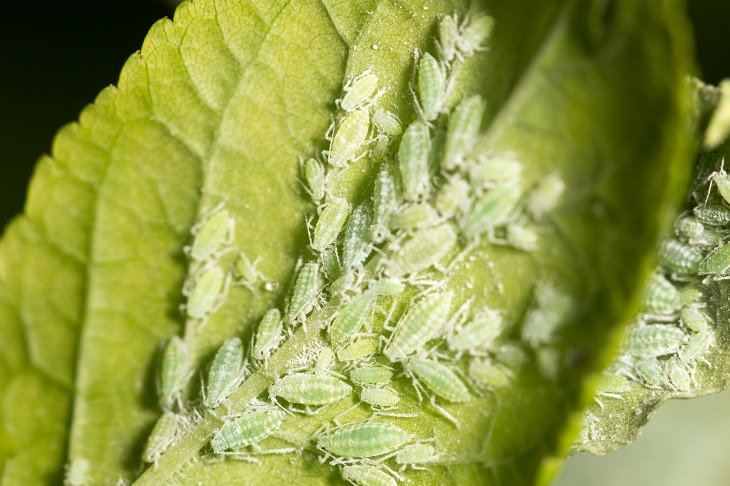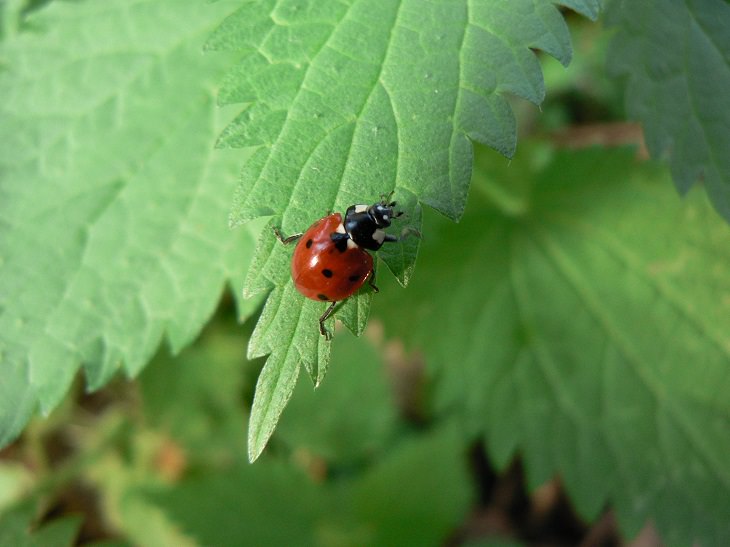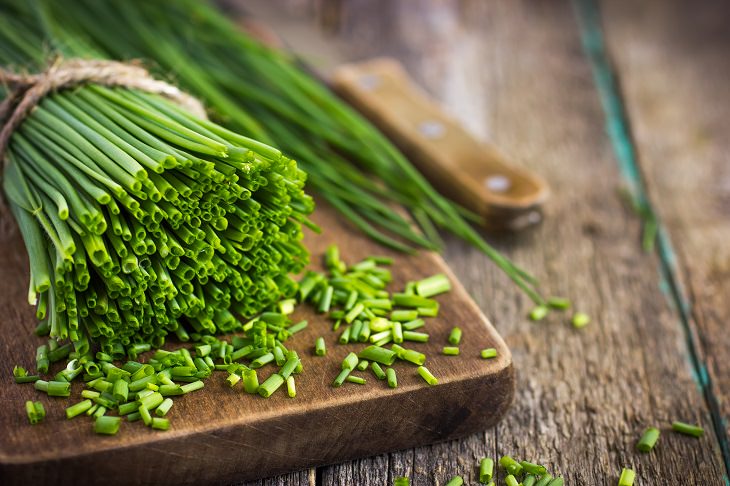
If the leaves or stems of the plants in your garden are covered with a sticky substance, it’s a clear sign that aphids may have been sipping sap from them. No matter how meticulous you are, aphids always seem to find a way into every garden.
Aphids are small white bugs that can usually be found feeding on a wide variety of plants and fruit-bearing trees, such as beans, cabbages, roses, potatoes, melons, apples, and peaches. The feed on plant juices – munching their way through leaves, buds, flowers, stems, fruits, and even the roots. As a result, your plants will become distorted and deformed.

Apart from the sticky substance covering the leaves or stems, other signs of this common garden pest include misshapen. Stunted, curling, or yellowing leaves, and a sudden increase in the ant population in your garden. These little critters multiply quickly, so it’s best to control them before reproduction starts.
Thankfully, there are many simple and effective ways to get rid of aphids. Here are 10 of them:
1. Manual Removal
If the infestation is only minor and the damage to your plants has just started, you might be able to physically remove the aphids. All you will need is a good pair of gardening gloves and a brush. You can brush the insects off the leaves and stems into a container.
Another option is to cut off infected stalks, which will help prevent the aphids from spreading to healthy parts of the plant.
You can kill the aphids by dropping them into a bucket of soapy water.
2. Blasts of Water
Fill your garden sprayer with water and start hosing down your plants, particularly on the tops and bottoms of the leaves. Always spray your infected plants in the early morning when the sun is not very hot, and when it’s not going to rain.
After a couple of days, if you still see aphids on your plants, give them another spray.
Method:
1. Place 2 tablespoons of neem oil and 1 tablespoon of mild liquid soap in a spray bottle.
2. Fill the rest of the bottle with water, and shake well to mix up the ingredients.
3. Spray the solution on your plants, either in the morning or evening to avoid the sun.
4. Repeat 2-3 times a week, or as needed.

The sulfur present in garlic is toxic to pests. Furthermore, it’s an antifungal agent, so helps to keep your plant free of fungal-related diseases.
Method:
1. Mince 3-4 cloves of garlic and add them to 2 teaspoons of mineral oil.
2. Let the mixture sit for 24 hours.
3. Strain out the garlic pieces.
4. Add the garlic-infused oil to 2 cups of water.
5. Add 1 teaspoon of liquid dish soap and mix well. You can also add a little cayenne pepper.
6. Put 2 tablespoons of the mixture into a spray bottle, along with 2 cups of water.
7. Spray it on the infected plants, paying close attention to the undersides of the leaves.
8. Repeat 1-2 times a week, as needed.
4. Food-Grade Diatomaceous Earth
This is a natural insecticide that is made up of the fossils of tiny aquatic organisms known as diatoms. The microscopically sharp edges of diatoms can cut through the protective coverings of insects, and ultimately kill them.
Method:
1. Dust some food grade DE around your garden and plants.
2. Do this in the early morning or late evening when the plants are wet with dew. The moisture will help the DE stick to the plant.
3. Repeat once or twice a week as needed.
Note: when working with DE, wear a respiratory dust mask and safety goggles to protect your respiratory tract and eyes.
5. Neem Oil
Neem oil is a natural garden pesticide and insect repellent that deters and kills aphids. This oil is also effective on other plant-eating pests such as beetles, ants, caterpillars, leaf miners, and cabbage worms. Furthermore, it helps control fungal growth in your garden.

You can also protect your plants from aphids by introducing proactive bugs into your garden. Ladybirds, also known as ladybug beetles, are beneficial bugs that you can easily find in gardening stores. These beautiful little creatures can eat as many as 50-100 aphids per day.
Purchases these bugs and place them in close proximity to the infected area, so they can start dining right away.
7. Liquid Soap
You can get rid of a mild to moderate aphid infestation using liquid soap.
Aphids have a waxy protective coating on their bodies that dissolves when it comes into contact with soapy water. This dehydrates the insects and eventually kills them without harming the plant.
Method:
1. Put 1 quart of water and 1 teaspoon of liquid dish soap in a spray bottle.
2. Shake it thoroughly, then spray on the infected plants. Do it either in the early morning or late evening.
3. Repeat every 2-3 days for 2 weeks.
8. Tomato Leaves
Tomato plants contain toxic compounds known as alkaloids in their leaves. These are toxic to aphids and help get rid of them safely.
Method:
1. Soak 1-2 cups of chopped tomato leaves in 2 cups of water overnight.
2. The next morning, strain the leaves out of the liquid.
3. Add another cup of water to the liquid, and add to a spray bottle.
4. Spray it on the stems and foliage of the infected plants.
5. Spray 1-2 times a week, as needed.

Along with introducing helpful bugs into your garden, you can also add some helpful plants to get rid of aphids. These plants include mustard, oregano, catnip, dill, fennel, clover, garlic, chives, and nasturtium.
10. Organic Fertilizers
Do not use fertilizers in your garden that are high in nitrogen, as this promotes aphid reproduction. In fact, these small insects are attracted to plants with high nitrogen levels.
To prevent high nitrogen levels in your plants, it’s recommended that you use compost or organic fertilizers. These types of fertilizers release nutrients slowly and are hugely beneficial to your plants.
Additional Tips
• Simply spraying onion or garlic juice on the infected parts of the plant can also help control an aphid infestation.
• Thoroughly check around your garden before planting your vegetables to see if aphids are already present in the area.
• Grow plants inside or under a cover until they are big enough to be more tolerant of pests.
• When using any type of spray, test it first by spraying it on an inconspicuous part of the plant to see if it harms it.
Source: top10homeremedies
Images: depositphotos